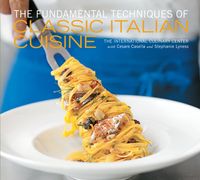Advertisement
Working with Fish
Appears in
The term “fish” (pesce) is applied broadly to a class of aquatic, cold-blooded animals. The term is also frequently—if inaccurately—used to refer to shellfish, such as shrimp or clams. For the purposes of this curriculum, “fish” will refer to cold-blooded vertebrates that consist of four main parts: the head, the trunk or body, the tail, and the fins.
Most fish are 70 percent water and 10 to 20 percent protein, with traces of minerals, vitamins A, B, and D, carbohydrates, and lipids. Fish oil, or fat, has been hailed for its health benefits for centuries. The fattiest fish contain the most beneficial oils; all fish, however, provide high amounts of lean protein and nutrients. Fatty fish such as salmon and herring contain approximately 160 calories per 100 grams (3½ ounces). Lean fish such as bass and barramundi contain 70 calories per 100 grams (3½ ounces).

